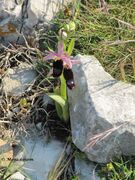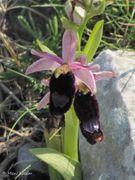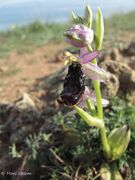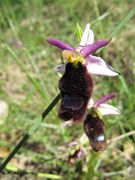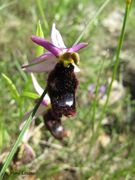Ophrys bertolonii Moretti, 1823
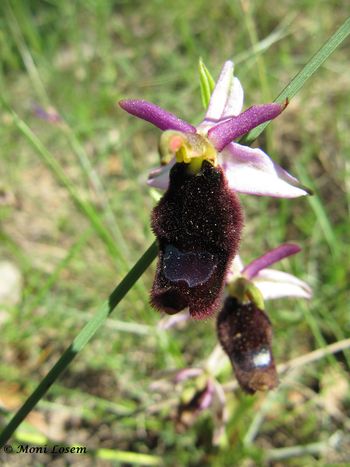
Ophrys bertolonii Moretti, 1823 - Bertolonis Ragwurz, Bertolonijeva kokica
Sie ist für mich eine der schönsten Orchideen, die ab April ihre spektakulären Blüten Richtung Sonne streckt. Man erkennt sie leicht an der langen, tiefdunklen Lippe mit dem breiten Spiegel und dem winzigen gelben Fleck an der Spitze.
Diese Orchidee wird von der Schwarzen Mörtelbiene bestäubt und lebt in Symbiose mit verschiedenen Pilzen der Familie Tulasnellaceae Juel 1897.
Sie gehört zu den gefährdeten Orchideen in Kroatien und hat den Status VU (vulnerable). Diese Ragwurz ist streng geschützt und gehört zu den national wichtigen Pflanzen in verschiedenen Natura 2000 Habitaten (Murter, Telašćica, Otok Cres u.a.)
Ophrys bertolonii Moretti, 1823 - Bertoloni's bee orchid, Bertolonijeva kokica
For me, it is one of the most beautiful orchids, extending its spectacular flowers from April towards the sun. You can easily determine it by the long, deep, dark lip with the wide mirror and the tiny yellow spot on the tip.
This orchid is pollinated by Megachile parietina Fourcroy, 1785 and lives in symbiosis with various mushrooms of the family Tulasnellaceae Juel 1897.
It is one of the endangered orchids in Croatia and has the status VU (vulnerable). This insect orchis is strictly protected and one of the nationally important plants in various Natura 2000 habitats (Murter, Telašćica, Otok Cres etc.)
Systematik
- Klasse Magnoliopsida Brongniart, 1843 - Bedecktsamer, kritosjemenjače
- Gruppe Monokotyledonen - Einkeimblättrige, jednosupnice
- Ordnung Asparagales Link, 1829 – Spargelartiage, šparogolike
- Familie Orchidaceae Jussieu, 1789 - Orchideengewächse, kaćuni
- Unterfamilie Orchidoideae Lindley. 1826
- Tribus Orchideae Vermeulen, 1977
- Subtribus Orchidinae Verneulen, 1977
- Gattung Ophrys Linné, 1753 – Ragwurz, kokošica
Trivialnamen
- Deutsch: Bertolonis Ragwurz
- Kroatisch: Bertolonijeva kokica
- Englisch: Bertoloni's Bee Orchid
- Französisch: L'ophrys de Bertoloni, ophrys gardésan
- Italienisch: L'ofride di Bertoloni, ofride del lago di Garda
- Slowenisch: Bertolonijevo mačje uho
- Spanisch: orquídea abeja de Bertoloni
- Tschechisch xxx
- Ungarisch: xxx
Wissenschaftlicher Name
Ophrys bertolonii Moretti, 1823
Namensherkunft
Artname bertolonii = nach dem italienischen Botaniker Antonio Bertoloni, 1775 - 1869
Basionym
Ophrys bertolonii Moretti, 1823
Synonyme
- Arachnites insengae Todaro, 1858
- Ophrys bertolonii var. dalmatica Murr, 1901
- Ophrys penedensis Kalkhoff, 1914
- Ophrys dalmatica (Murr) Soó, 1926
Schutzstatus
- Gefährdete Pflanze:In der Roten Liste Kroatiens hat Ophrys bertolonii Moretti, 1823 den Status VU
- Geschützte Pflanze: Ophrys bertolonii Moretti, 1823 ist in Kroatien streng geschützt. :( → Siehe Amtsblatt 162/03)
- Ophrys bertolonii Moretti, 1823 ist in der IUCN Red List mit dem Status LC aufgeführt.
- Natura 2000 in Kroatien: Ophrys bertolonii Moretti, 1823 ist in der Liste der national wichtigen Arten in folgenden Habitaten aufgelistet:
- ✔ HR4000002 Park prirode Telašćica
- ✔ HR3000126 Ušće Cetine
- ✔ HR2000616 Donji Kamenjak
- ✔ HR2001352 Mosor
- ✔ HR2001050 Murter
- ✔ HR2001358 Otok Cres
- ✔ HR3000078 Otok Tukošćak i o. Mrtonjak
- Der internationale Handel mit Ophrys bertolonii Moretti, 1823 ist reglementiert durch CITES (Washingtoner Artenschutzabkommen), Annex II
Morphologie und Größe
Habitus
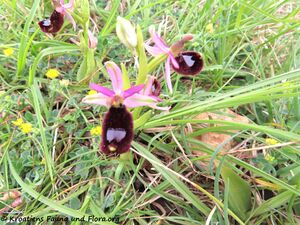
- Diese Orchidee fällt durch ihre langen, gebogenen Blüten und den gedrungenen Wuchs auf.
- Es ist eine mehrjährige, krautige Pflanze.
- Höhe: bis 15 cm
Die Blüte
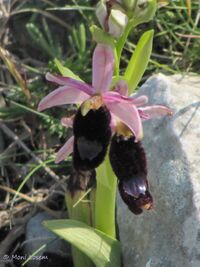
- 3-zählige Blüte mit hellvioletten bis rosa Kelchblättern. Die Kronblätter dieser Variante sind rosa, die mittlere mit einem deutlichen Strich.
- Die Lippe ist lang und behaart, das Schild ist im unteren Drittel. An der Lippenspitze ist ein kleiner gelber Fortsatz. Die Lippe selbst ist tiefviolett und stark behaart.
- Jede Blüte wird von einem hellgrünen Hochblatt begleitet.
- Blütezeit : April bis Mai
- Durchmesser der Blüte: 10 mm
- Blütenfarbe: violett: Kronblätter helllila, Lippe fast schwarz mit glänzendem Spiegel
Die Frucht
Reifezeit: Juni
Das Blatt
- Die hellgrünen Blätter sind breit und zugespitzt.
Ökologie
- Diese Orchidee wird von Männchen der Schwarzen Mörtelbiene - Megachile parietina Fourcroy, 1785, Familie Megachilidae Latreille, 1802 – bestäubt. Die Ähnlichkeit der Lippe der Blüte mit dem Hinterleib des Weibchens ist verblüffend.
- Als symbiontische Pilze wurden verschiedene Arten der Familie Tulasnellaceae Juel 1897 beschrieben.
Lebensraum
- Trockene, kalkhaltige Fluren. Meist direkt an größeren Steinen.
- Ophrys bertolonii Moretti, 1823 ist Charakterart von folgendem EUNIS-Habitat:
Geografische Verbreitung
- Herkunft: Zentraler Mittelmeerraum, zahlreiche Unterarten und Hybriden
- Vorkommen: Zentraler Mittelmeerraum
- Fundort: Kroatien – Otok Vir, Bandira
Nutzung
Es ist keine Nutzung von Ophrys bertolonii Moretti, 1823 bekannt.
Weiterführende Literatur und Quellen
© Kroatiens Fauna und Flora, fauna i flora u Hrvatskoj
- Die Richtlinien für Kroatiens Fauna und Flora: [[1]]
- Kroatiens Fauna und Flora - Aktuelles
- Plavi muzej i plavi kafe
- Artikel 62, Absatz 3 des Naturschutzgesetzes (Amtsblatt 162/03)
- Crvena Knijga
- Encyclopedia of Life EoL
- EPPO
- European Environment Agency EUNIS
- EUNIS Factsheet E1.332 - Helleno-Balkanic short grass and therophyte communities
- CITES (Washingtoner Artenschutzabkommen), Annex II
- Forum Acta Plantarum
- Flora Croatica Database
- Global Diversity Information Facility GBiF
- Günther Blaich
- Inventaire National du Patrimoine Naturel INPN
- IUCN Red List
- Natura 2000 HR
- PAN-European species directories infrastructure - PESI
- The Plant list
- Wikispecies
- Lorenzo Pecoraro, Mariangela Girlanda, Zhong-Jian Liu, Laiqiang Huang, Silvia Perotto 2015 [2] Molecular analysis of fungi associated with the Mediterranean orchid Ophrys bertolonii Mor. Springer-Verlag Berlin Heidelberg and the University of Milan, 2015. DOI 10.1007/s13213-015-1038-9
